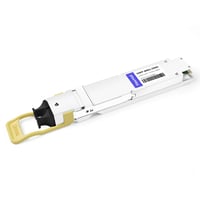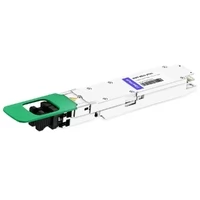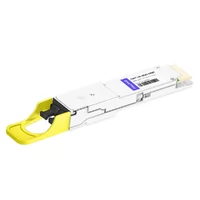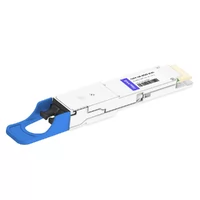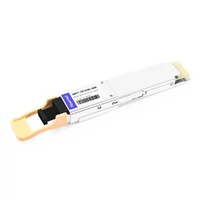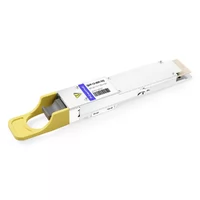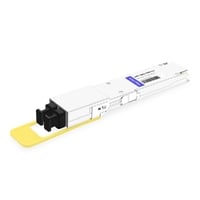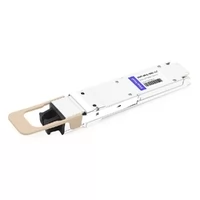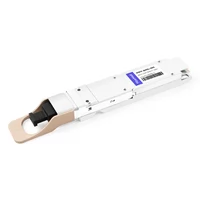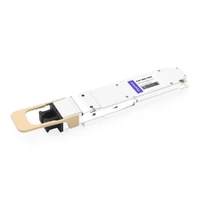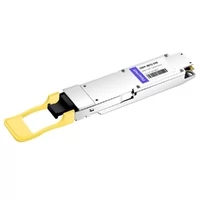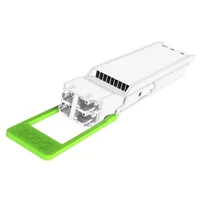In today’s fast-paced world, the demand for high-speed data transmission has reached unprecedented levels. AI applications and large models have made computing power a key infrastructure for the AI industry. As the need for faster communication increases, high-speed optical modules have become an essential component of artificial intelligence servers. This article explores the evolution of 800G optical modules and their huge potential in the AI era.
Table of Contents
ToggleThe Evolution of 800G Optical Modules
Optical modules perform the task of converting optical and electrical signals in network connections, responsible for converting electrical signals into optical signals at the transmitting end, and then converting optical signals into electrical signals at the receiving end after transmission through optical fibers. With the development and integration of optoelectronic devices, their performance and transmission bandwidth have been continuously improved, and optical modules require higher transmission rates and smaller sizes to adapt to different usage scenarios. The packaging methods have also evolved, and smaller packaging and power consumption means that optical modules have a higher port density on switches, and the same power can drive more optical modules.
Increasing bandwidth demand
The growth of bandwidth demand has had a significant impact on high-speed optical modules. With the emergence of new technologies and the demand for large-scale data transmission, traditional 100G, 200G, and 400G optical modules can no longer fully meet market demand. To meet the growing bandwidth demand, 800G optical modules are becoming a trend.
The growth of LPO technology
In the 800G optical module era, Linear-drive Pluggable Optics (LPO) technology stands out. LPO uses linear analog components in the data link, without the need for complex CDR or DSP design. Compared with DSP solutions, LPO greatly reduces power consumption and latency and is very suitable for the short-distance, high-bandwidth, low-power, and low-latency data connection requirements of AI data centers. As cloud service providers expand their computing resources, LPO solutions, including 800G LPO, are expected to occupy an important market share.
800G Optical Module Packaging
With the continuous advancement of technology, the packaging form of optical modules has undergone significant changes. From the early GBIC packaging to the smaller SFP packaging, to the current 800G QSFP-DD and OSFP packaging. This development trend not only reflects the continuous improvement of optical modules in terms of rate but also shows their progress toward miniaturization and hot plugging. The application scenarios of 800G optical modules are increasingly diverse, covering multiple fields such as Ethernet, CWDM/DWDM, connectors, fiber channels, and wired/wireless access.
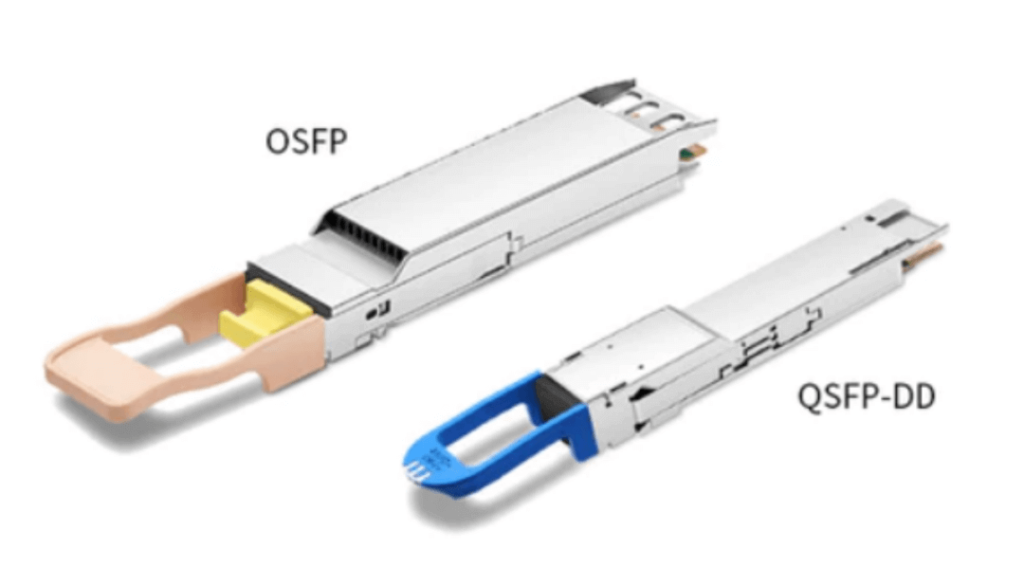
Comparison of QSFP-DD and OSFP sizes
800G QSFP-DD specifications
Double-density four-channel small pluggable high-speed module. QSFP-DD is the preferred packaging for 800G optical modules, enabling data centers to grow efficiently and expand cloud capacity as needed. QSFP-DD modules use an 8-channel electrical interface, with a rate of up to 25Gb/s (NRZ modulation) or 50Gb/s (PAM4 modulation) per channel, providing an aggregate solution of up to 200Gb/s or 400Gb/s.
The advantages of 800G QSFP-DD
It has downward compatibility and is compatible with QSFP+/QSFP28/QSFP56 QSFP packages.
It adopts a 2×1 stacked integrated cage connector, which can support single-height and double-height cage connector systems.
It can achieve a thermal capacity of at least 12 watts per module through SMT connectors and 1xN cages. Higher thermal capacity can reduce the cooling function requirements of optical modules, thereby reducing some unnecessary costs.
In the design of QSFP-DD, the MSA working group fully considered the flexibility of user use, adopted ASIC design, supported multiple interface rates, and was downward compatible (compatible with QSFP+/QSFP28), thereby reducing port costs and equipment deployment costs.
800G OSFP shape specifications
OSFP is a new type of optical module, much smaller than CFP8, but slightly larger than QSFP-DD, with 8 high-speed electrical channels, and still supports 32 OSFP ports on each 1U front panel, with integrated heat sinks to greatly improve heat dissipation performance.
The advantages of 800G OSFP
The OSFP module is designed for 8 channels, directly supporting a total throughput of up to 800G, thereby achieving higher bandwidth density.
Because the OSFP package supports more channels and higher data transmission rates, it can provide higher performance and longer transmission distance.
The OSFP module has an excellent heat dissipation design and can handle higher power consumption.
OSFP is designed to support higher rates in the future. Due to the larger size of the OSFP module, it is possible to support higher power consumption, thereby supporting higher rates, such as 1.6T or higher.
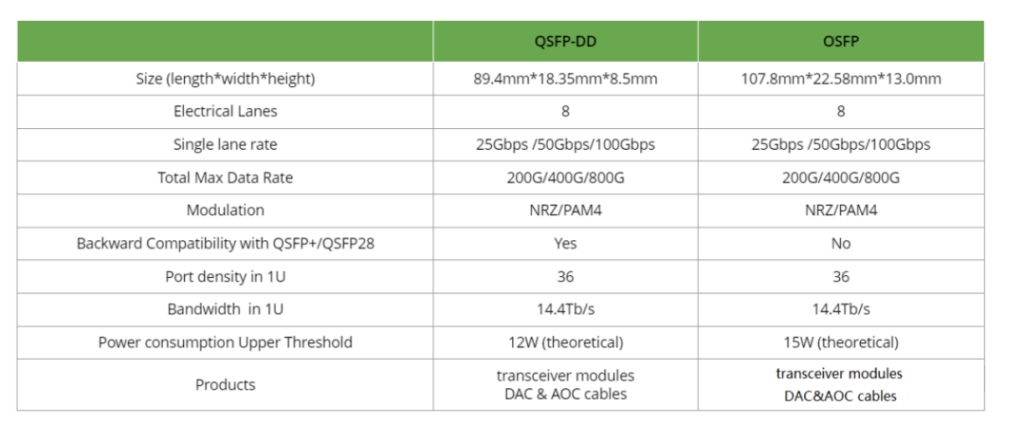
Comparison of 800G optical module size
QSFP-DD is usually the preferred choice in telecom applications, while OSFP is more suitable for data center environments. The main differences between them are:
Size: OSFP is slightly larger
Power consumption: OSFP’s power consumption is slightly higher than QSFP-DD.
Compatibility: QSFP-DD is perfectly compatible with QSFP28 and QSFP+, while OSFP is not compatible.
Types of 800G Optical Modules
800G=8x100G=4x200G, so according to the single-channel rate, it can be divided into two types, namely single-channel 100G and 200G. The corresponding architectures are shown in the figure below. The single-channel 100G optical module can be quickly implemented, while 200G has higher requirements for optical devices. Since the maximum rate supported by the current electrical interface is 112Gbps PAM4, a gearbox is required for the single-channel 200G.
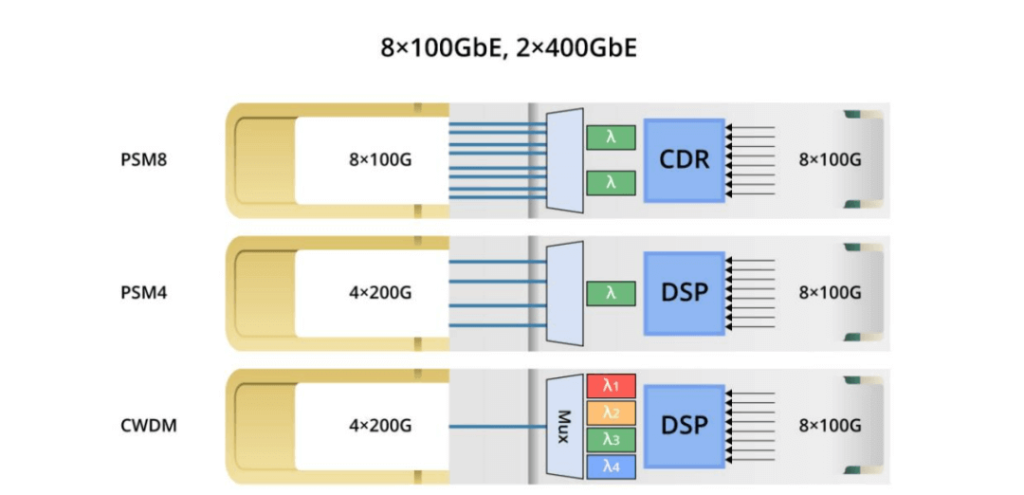
For the multimode case, there are mainly two standards for 800G optical modules, corresponding to a transmission distance less than 100m.
800G SR8
It adopts the VCSEL solution, with a wavelength of 850nm, a single-channel rate of 100Gbps PAM4, and requires 16 fibers. This can be regarded as an upgraded version of 400G SR4, with the number of channels doubled. Its optical interface is MPO-16 or 2 rows of MPO-12, as shown in the figure below. 800G SR8 optical modules are generally used for 800G Ethernet, data center links, or 800G-800G interconnection.

800G SR4
This solution adopts 850nm/910nm wavelength, bidirectional transmission, and uses DeMux in the module to separate the two wavelengths. The single-channel rate is 100Gbps PAM4, and 8 fibers are required. Compared with SR8, the number of fibers in this solution is reduced by half. Its block diagram is shown in the figure below:
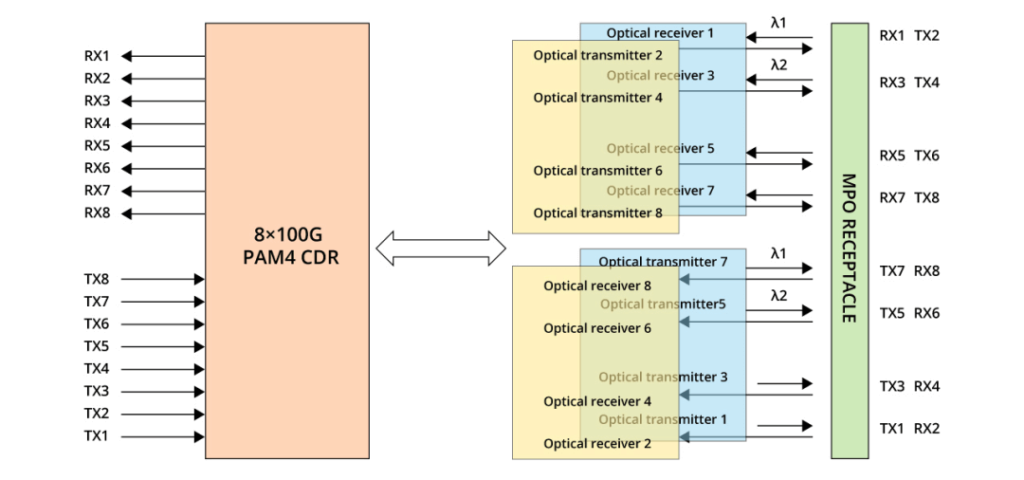
800G PAM4 CDR
Its fiber interface is shown in the figure below, using the MPO-12 interface.

There are various standards for 800G optical modules for single-mode applications:
800G DR8, 800G 2xDR4, and 800G PSM8
These three standards have similar internal architectures, all with 8 transmitters and 8 receivers, and a single-channel rate of 100Gbps, requiring 16 optical fibers. 800G DR8 optical module adopts 100G PAM4 and 8-channel single-mode parallel technology, and the transmission distance through single-mode optical fiber can reach 500m.
It is usually used for data center, 800G-800G, 800G-400G, and 800G-100G interconnection. 800G PSM8 adopts CWDM technology, with 8 optical channels, each with a transmission rate of 100Gbps, supporting a transmission distance of 100m. It is very suitable for long-distance transmission and fiber resource sharing.
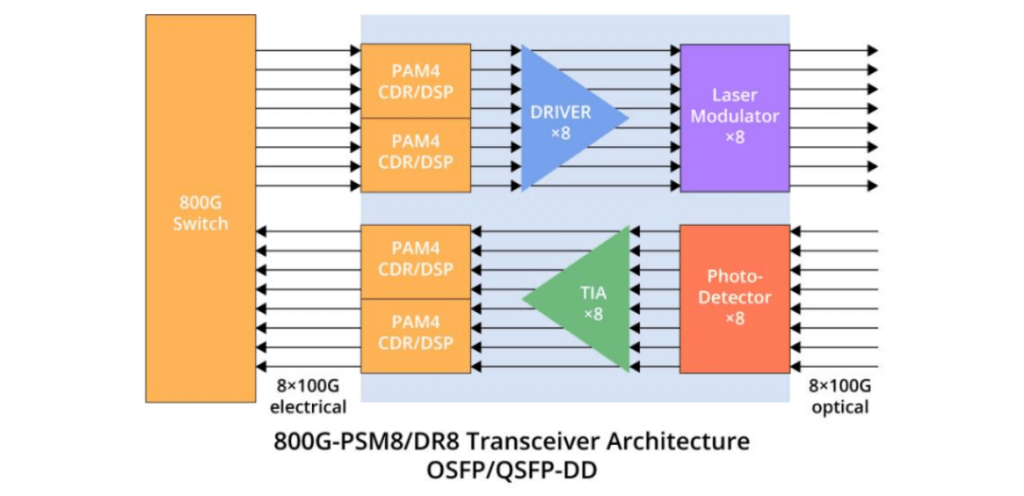
800G 2DR4 refers to 2 “400G-DR4” interfaces. The optical interface of 2DR4 is 2 MPO-12, as shown in the figure below. It can be interconnected with 400G DR4 optical module without fiber branch cable, supporting 500m transmission distance, which is convenient for data center upgrades. The optical interface of PSM8 and DR8 is MPO-16.
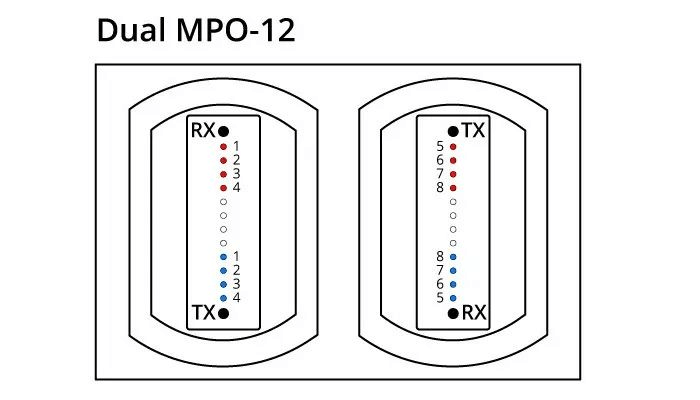
800G 2xFR4 and 2xLR4
These two standards have similar internal structures, both containing 4 wavelengths and a single-channel rate of 100Gbps. By using Mux to reduce the number of optical fibers, 4 optical fibers are required, as shown in the figure below.
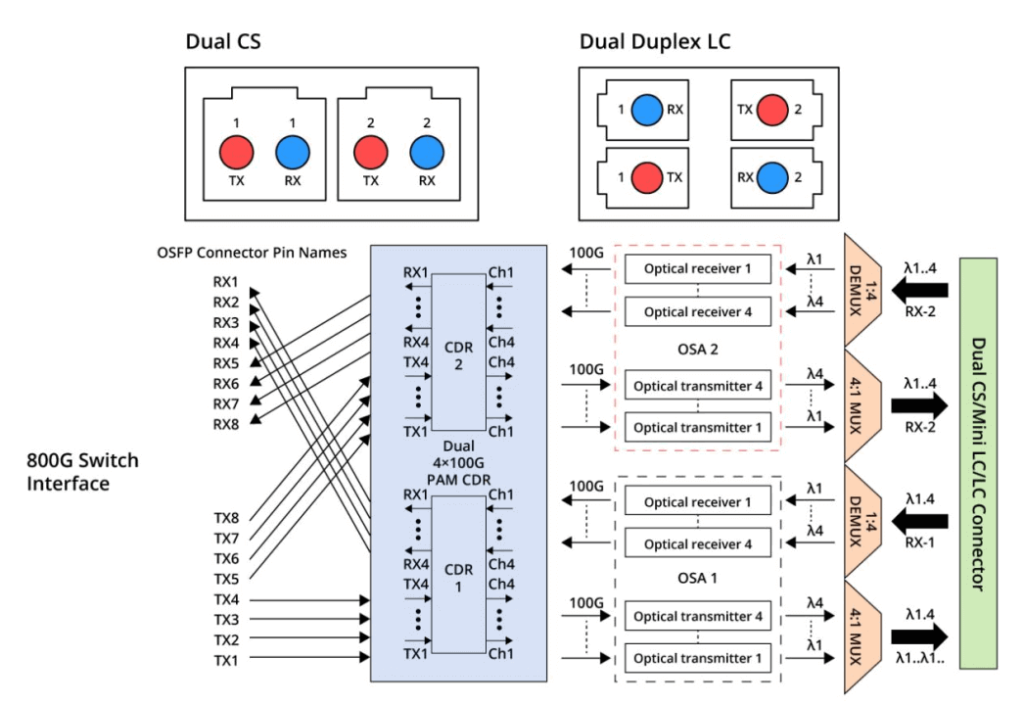
These two solutions are upgrades of 400G FR4 and LR4 optical modules, using 1271/1291/1311/1331nm CWDM4 wavelengths. 2xFR4 supports a transmission distance of 2km, and 2xLR4 supports a transmission distance of 10km. Their optical interfaces adopt dual CS or dual duplex LC interfaces.
800G FR4
This solution uses four wavelengths, with a single-channel rate of 200Gbps, requiring two optical fibers to support a transmission distance of 2km, as shown in the figure below.
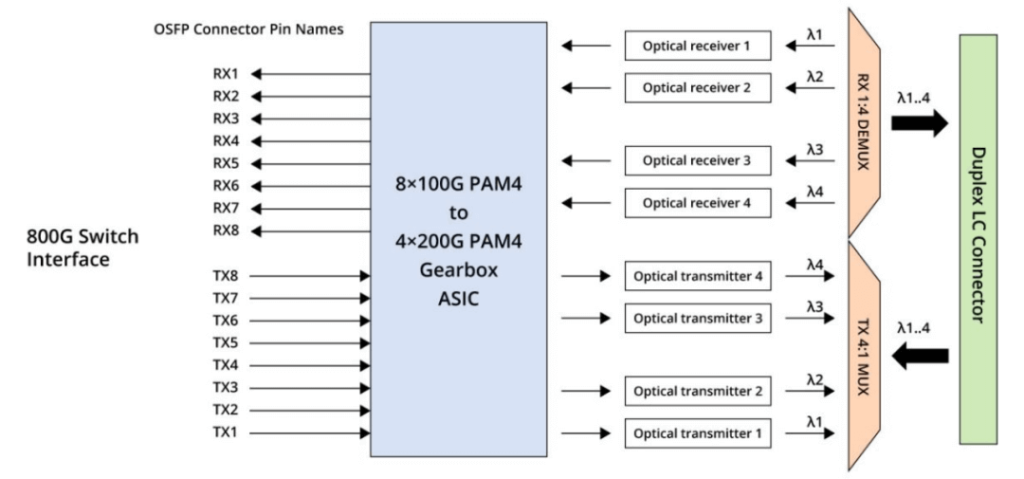
It adopts a duplex LC optical interface, as shown in the figure below.
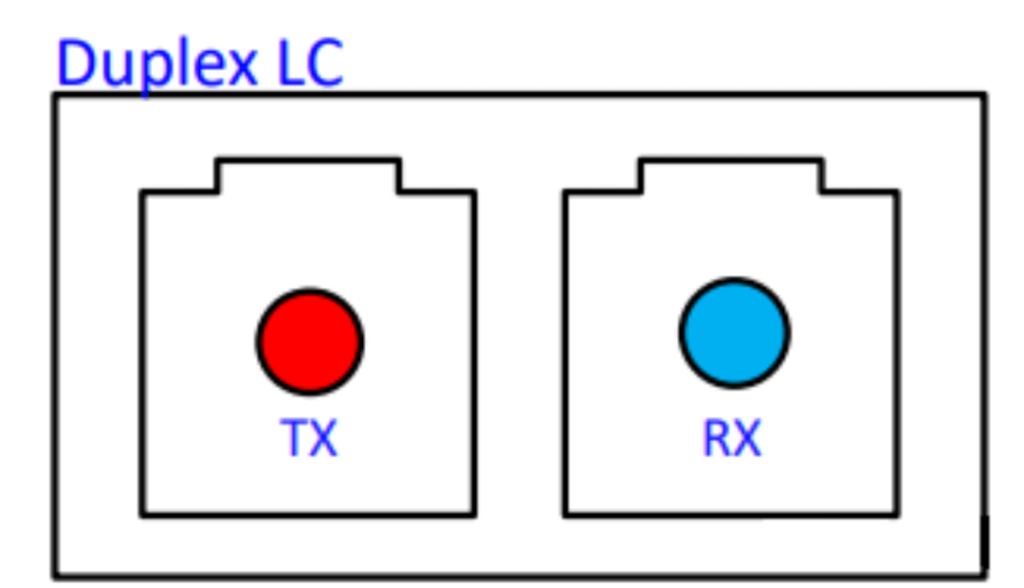
800G FR8
This solution uses 8 wavelengths, each with a rate of 100Gbps, requiring two optical fibers to support a transmission distance of 2km, as shown in the figure below. The eight wavelength channels are 1271/1291/1311/1331/1351/1371/1391/1411nm respectively.
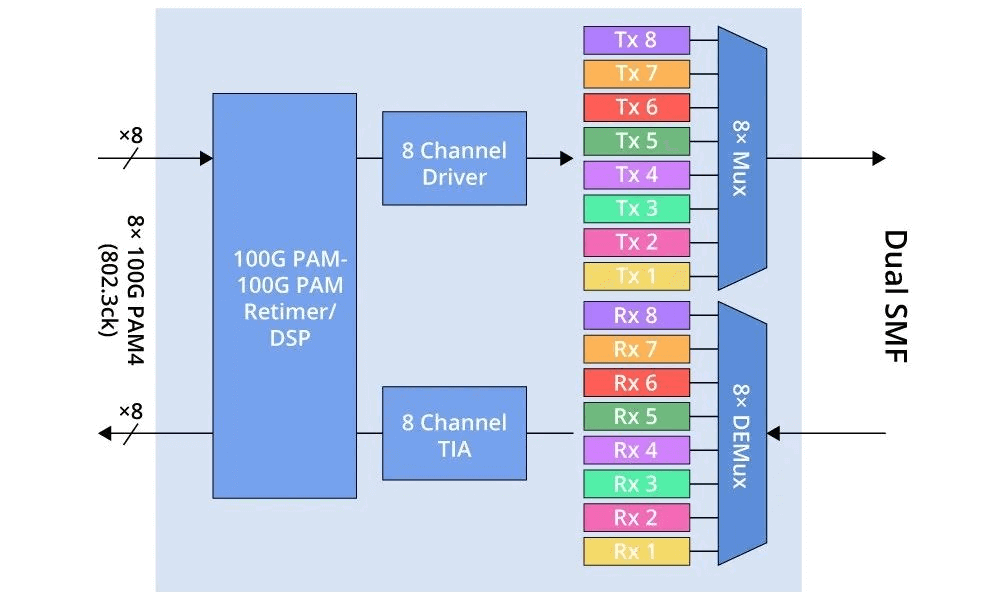
The impact of Al on the deployment of 800G optical modules
Why is 800G more important than 400G for AI servers?
First of all, AI servers require high data transmission rate and low latency and need rack-top switches that match the underlying bandwidth. These switches may also need latency redundancy, which requires high-speed optical modules. For example, NVIDIA DGX H100 server is equipped with 8xH100 GPU modules, each of which requires 2x200G optical modules. Therefore, each server needs at least 16x200G modules, and the corresponding rack-top switch port needs at least 4x800G.
Secondly, 800G optical chips have higher cost efficiency and economic benefits. They use 100G EML chips, while 200G/400G use 50G optical chips. Data shows that at the same rate, the cost of a 100G optical chip is 30% lower than that of two 50G optical chips. Nevertheless, 400G optical modules still have important significance in the industry.
Although they may not be able to match the speed of 800G optical modules, they significantly improve the bandwidth compared to old technologies, and are the preferred solution for many enterprises. In addition, some applications may not need all the features of 800G Ethernet, and 400G Ethernet is more practical for them. With the increasing demand for faster and more efficient data transmission, the era of 800G optical modules has arrived.
With their excellent bandwidth capabilities and the advancement of LPO technology, 800G optical modules will completely change the artificial intelligence industry and data center.
Related Products:
-
 NVIDIA MMS4X00-NS Compatible 800Gb/s Twin-port OSFP 2x400G PAM4 1310nm 100m DOM Dual MTP/MPO-12 SMF Optical Transceiver Module
$850.00
NVIDIA MMS4X00-NS Compatible 800Gb/s Twin-port OSFP 2x400G PAM4 1310nm 100m DOM Dual MTP/MPO-12 SMF Optical Transceiver Module
$850.00
-
 NVIDIA MMA4Z00-NS Compatible 800Gb/s Twin-port OSFP 2x400G SR8 PAM4 850nm 100m DOM Dual MPO-12 MMF Optical Transceiver Module
$650.00
NVIDIA MMA4Z00-NS Compatible 800Gb/s Twin-port OSFP 2x400G SR8 PAM4 850nm 100m DOM Dual MPO-12 MMF Optical Transceiver Module
$650.00
-
 NVIDIA MMS4X50-NM Compatible OSFP 2x400G FR4 PAM4 1310nm 2km DOM Dual Duplex LC SMF Optical Transceiver Module
$1200.00
NVIDIA MMS4X50-NM Compatible OSFP 2x400G FR4 PAM4 1310nm 2km DOM Dual Duplex LC SMF Optical Transceiver Module
$1200.00
-
 NVIDIA MMS4X00-NM-FLT Compatible 800G Twin-port OSFP 2x400G Flat Top PAM4 1310nm 500m DOM Dual MTP/MPO-12 SMF Optical Transceiver Module
$1199.00
NVIDIA MMS4X00-NM-FLT Compatible 800G Twin-port OSFP 2x400G Flat Top PAM4 1310nm 500m DOM Dual MTP/MPO-12 SMF Optical Transceiver Module
$1199.00
-
 NVIDIA MMA4Z00-NS-FLT Compatible 800Gb/s Twin-port OSFP 2x400G SR8 PAM4 850nm 100m DOM Dual MPO-12 MMF Optical Transceiver Module
$650.00
NVIDIA MMA4Z00-NS-FLT Compatible 800Gb/s Twin-port OSFP 2x400G SR8 PAM4 850nm 100m DOM Dual MPO-12 MMF Optical Transceiver Module
$650.00
-
 NVIDIA MMS4X00-NM Compatible 800Gb/s Twin-port OSFP 2x400G PAM4 1310nm 500m DOM Dual MTP/MPO-12 SMF Optical Transceiver Module
$900.00
NVIDIA MMS4X00-NM Compatible 800Gb/s Twin-port OSFP 2x400G PAM4 1310nm 500m DOM Dual MTP/MPO-12 SMF Optical Transceiver Module
$900.00
-
 QSFP-DD-800G-DR8D QSFP-DD 8x100G DR PAM4 1310nm 500m DOM Dual MPO-12 SMF Optical Transceiver Module
$1250.00
QSFP-DD-800G-DR8D QSFP-DD 8x100G DR PAM4 1310nm 500m DOM Dual MPO-12 SMF Optical Transceiver Module
$1250.00
-
 QSFP-DD-800G-2LR4 QSFP-DD 2x400G LR4 PAM4 CWDM4 10km Dual CS SMF FEC Optical Transceiver Module
$2100.00
QSFP-DD-800G-2LR4 QSFP-DD 2x400G LR4 PAM4 CWDM4 10km Dual CS SMF FEC Optical Transceiver Module
$2100.00
-
 QSFP-DD-800G-SR8 800G SR8 QSFP-DD 850nm 100m OM4 MMF MPO-16 Optical Transceiver Module
$850.00
QSFP-DD-800G-SR8 800G SR8 QSFP-DD 850nm 100m OM4 MMF MPO-16 Optical Transceiver Module
$850.00
-
 QSFP-DD-800G-DR8 800G-DR8 QSFP-DD PAM4 1310nm 500m DOM MTP/MPO-16 SMF Optical Transceiver Module
$1300.00
QSFP-DD-800G-DR8 800G-DR8 QSFP-DD PAM4 1310nm 500m DOM MTP/MPO-16 SMF Optical Transceiver Module
$1300.00
-
 OSFP-800G-DR8D-FLT 800G-DR8 OSFP Flat Top PAM4 1310nm 500m DOM Dual MTP/MPO-12 SMF Optical Transceiver Module
$1199.00
OSFP-800G-DR8D-FLT 800G-DR8 OSFP Flat Top PAM4 1310nm 500m DOM Dual MTP/MPO-12 SMF Optical Transceiver Module
$1199.00
-
 OSFP-800G-SR8D-FLT OSFP 8x100G SR8 Flat Top PAM4 850nm 100m DOM Dual MPO-12 MMF Optical Transceiver Module
$650.00
OSFP-800G-SR8D-FLT OSFP 8x100G SR8 Flat Top PAM4 850nm 100m DOM Dual MPO-12 MMF Optical Transceiver Module
$650.00
-
 OSFP-800G-SR8 OSFP 8x100G SR8 PAM4 850nm MTP/MPO-16 100m OM4 MMF FEC Optical Transceiver Module
$650.00
OSFP-800G-SR8 OSFP 8x100G SR8 PAM4 850nm MTP/MPO-16 100m OM4 MMF FEC Optical Transceiver Module
$650.00
-
 OSFP-800G-SR8D OSFP 8x100G SR8 PAM4 850nm 100m DOM Dual MPO-12 MMF Optical Transceiver Module
$650.00
OSFP-800G-SR8D OSFP 8x100G SR8 PAM4 850nm 100m DOM Dual MPO-12 MMF Optical Transceiver Module
$650.00
-
 OSFP-800G-DR8 OSFP 8x100G DR PAM4 1310nm MPO-16 500m SMF DDM Optical Transceiver Module
$900.00
OSFP-800G-DR8 OSFP 8x100G DR PAM4 1310nm MPO-16 500m SMF DDM Optical Transceiver Module
$900.00
-
 QSFP-DD-800G-FR4 800G QSFP-DD800 FR4 (200G per line) PAM4 CWDM 2km DOM Duplex LC SMF Optical Transceiver Module
$3500.00
QSFP-DD-800G-FR4 800G QSFP-DD800 FR4 (200G per line) PAM4 CWDM 2km DOM Duplex LC SMF Optical Transceiver Module
$3500.00
-
 QSFP-DD-800G-DR4 800G QSFP-DD800 DR4 (200G per line) 1311nm 500m Dual MPO-12 SMF Transceivers
$2850.00
QSFP-DD-800G-DR4 800G QSFP-DD800 DR4 (200G per line) 1311nm 500m Dual MPO-12 SMF Transceivers
$2850.00
-
 OSFP-800G-2FR2L 800G OSFP 2FR2 (200G per line) PAM4 1291/1311nm 2km DOM Duplex LC SMF Optical Transceiver Module
$3000.00
OSFP-800G-2FR2L 800G OSFP 2FR2 (200G per line) PAM4 1291/1311nm 2km DOM Duplex LC SMF Optical Transceiver Module
$3000.00

